Legal proceedings, sermons, and the creative industries; the universal applicability of law, the consensus of the flock, and corporate ethics. All of them require that you forget or repress something, that you pay a price for the (im)possibility of joining the fold. But what if you are in a court of law, or maybe listening to a sermon, or sitting at an office, and you can’t afford the fee? You start to suspect that the silent majority around you has already paid up, that they have become one with the laws of the state, God, or commerce, and this stirs your soul with anarchist protest: your imagination calls for riot and transgression. You want to subvert the serenity of all those present, all those who agree.
“There is so much of the repressed in this painting,” Sasha Novozhenova told me in front of The Venerable Sergei in His Youth, at an exhibition by Mikhail Nesterov1 in the Tretyakov Gallery: a scrofulous lad in a monk’s habit once again rolls his eyes ecstatically in the midst of Russian Nature, nothing but a frail vessel for the grace of God to fill his pretty boy’s body, as he waits with pale, clammy palms … It’s better to stop here, lest we give rise to too copious a stream of perverted fantasies and garbled fragments of the returning repressed: sex, femininity, and violence. It isn’t very hard to poke fun at Nesterov’s religious masterpieces at the exhibition “In Search of My Russia,” just like it isn’t hard to poke fun at Tikhon Shevkunov, the shifty archimandrite rumored to be Putin’s spiritual mentor. Yet neither are simply examples of an obscurantism utterly alien to this article’s enlightened readers. Instead, both are symptoms of modernity, a symptom of a condition that is very much our own—that we all have in common.
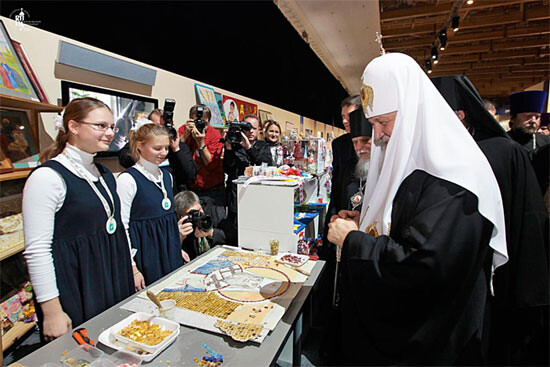

At a “creative meeting” with Archimandrite Tikhon at the Russian Academy of the Fine Arts, I could observe the production of consensus, a conservative consensus in this case. Tikhon managed to formulate all of his messages to this cultivated public in the most obvious, mediocre terms, as affirmations so rife with compromise that they would seem beyond the shadow of a doubt to anyone. It would seem that you’d heard all the twists and turns of his inquisitor’s reasoning many times before: Nikolai II was a saint as a family man, though not as a statesman; the USSR was a great power but lacked spirituality; Marx is Lenin’s forerunner and Lenin was the worst of villains (much worse than Ivan the Terrible!), but God will be his judge, and so on. These are the kind of banalities that you cannot question because you do not even notice them, though they mask a rigid and brutal structure of injunctions sometimes called ideology.
Shevkunov wove a subtle web, answering all of the audience’s questions with the reconciled omniscience of a universal man of God. He knew the essence of art (God vested man with the need to create, and man must realize this divine gift, praising his creator, etc.). He had grasped the logic of history and the meaning of human existence. Such an urge to cover all of human reality with a system of coordinates has its analogy in the legal system as it strives to systematize and account for all nuances of human behavior, becoming a totality, which is why Shevkunov’s speeches reminded me so much of a prosecutor’s argument in a court of law.
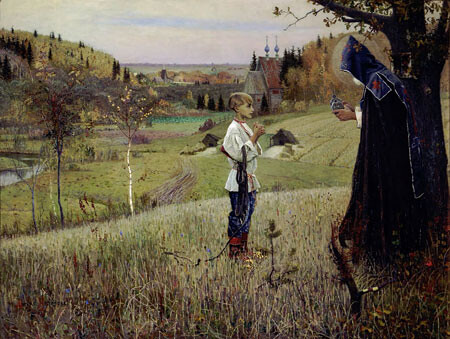

Moreover, Shevkunov’s customized conservative worldview is aptly constructed according to the laws of the human psyche, for example by using what Freud would have called “condensation.” Hence the expression “liberal-Bolshevik terror.” Shevkunov repeated it several times, referring to a generalized image of the enemies of “traditional values.” Such games played with the laws of consciousness mean that Tikhon is not so much a prosecutor as a copywriter.
Shevkunov is a great illustration for conservatism’s most elementary logic. Order and the state are good. Revolution is bad. The statist and nationalist pathos of Father Tikhon (our father who art … ) is most readable when he exploits the image of the Byzantine Empire and says that the Russian Empire and to an extent even the Soviet Union are its heirs. This associative connection finds its apogee in Shevkunov’s acclaimed film The Fall of an Empire: The Byzantine Lesson, in which the realia of Byzantium before the fall of Constantinople in 1453 serve as a ruse for the interpretation of recent Russian history. It is interesting that there are similarities between Shevkunov’s concept of the USSR and that found in Mikhail Nesterov’s painting. Both recognize the USSR for its great loners, its “spiritual people.” For Nesterov, these are the heroes of his portraits: figures like Pavlov, the Korin Brothers, Vera Mukhina, Shchusev, Yudin … To a contemporaneous viewer, Nesterov’s series of portraits surely looked conservatively stoic against the background of a contradictory epoch. But in Shevkunov, the idea that there were a few truly spiritual people who made the USSR into something good becomes a method for the retrospective affirmation of “eternal values”—those same Byzantine values, it would seem.
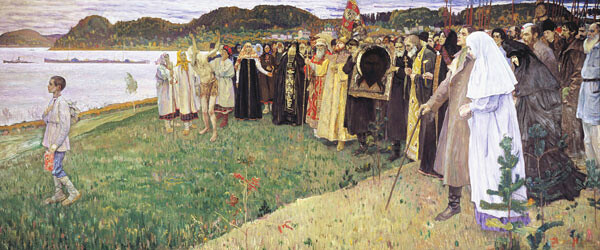

The air was stuffy. Patiently listening, the docile audience was made up of old academic painters (I noticed the artist Valentin Sidorov, for example) and Shevkunov’s young admirers, and there were even a few students from my art history department at the Historical Faculty of Moscow State University who seemed to have come on their own time to listen to the Archimandrite. Stern young men and modest young women, Russian Orthodoxy at its best, replete with the smugness of patriarchy. There were works by Gor Chakhal, Konstantin Khudyakov, and Nikolai Mukhin on the walls along with copies of Byzantine mosaics, and Shevkunov’s cadences were slow and measured. Once I’d gotten over the initial shock, I was overwhelmed by the monstrosity of the repressed that constituted the other side of this smugness, stuffiness, and moderation. It made me think of war propaganda for an Orthodox Russia: Nesterov’s canvas To Russia: The Soul of the People from 1916, where a sister of mercy takes by the hand a Russian soldier blinded in World War I and leads him to join the host of pilgrims in search of Christ. Lose your eyesight and perish for the Tsar, all for the promise of paradise! I also remembered the attitude of the police at the Russian Parliament during a picket protesting the law against propaganda about “untraditional” sexual orientations. They remained calm and even affable as they packed LGBT activists into police vans without so much as touching the fundamentalist activists waving their Bibles, crosses, eggs, and bottles of urine. Without anybody really noticing it, the police created a homosexual homo sacer, rejected and unprotected by the law.
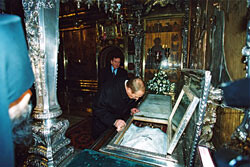

Shevkunov made a joke. The permanently tender inner smile of a girl watching him out of the corner of her eye now took on the contours of rapture. Her lips quivered, and a body tensed up in voluptuous Russian Orthodoxy appeared under her kerchief and ankle-length dress. Throw off your garment, young Sergei! I am the descendant of apes.
His arguments were those of a prosecutor. But let’s look at ourselves as employees of the culture industry: corporate ethics are no less rife with active repression, the flipside of their smugness no less of a nightmare. Service in the culture industry, with its cult of stars, its laws of loyalty to sponsors and potential consumers, inevitably engenders humiliating compromise. But on the strength of social, biographical, and psychological predilections, some find it easer to reconcile themselves to this illusion rather than another. And anyway, divine goodness has a tendency to turn into something nauseating. This is what Chekhov was writing about in “The Teacher of Literature,” in the second part of which everything that seemed so good in the first part turns out to be a fake decoration that needs to be kept intact in order to continue living somehow. For some, Russian Orthodoxy is the only way to stave off collapse.
There is a structural similarity between the logic of the creative industries, legal proceedings, and the Shevkunov’s of this world, and it characterizes our time. Giving some incidental support to the institution of the family, Tikhon kept comparing man’s relation to God with a child’s relation to his or her parents. Man was made in God’s “image and likeness,” he continued, but man has fallen astray of his source. In his deliberations, the necessity of clinging to the “image and likeness” of God-as-creator-and-parent turned out to be equivalent to the necessity of fully identifying with power, power in its political sense. That, according to Shevkunov, is the basis of a broad popular consensus: identification with a common Father. This is why it was a terrible sin to insult the Romanovs or to call Nikolai II by his diminutive “Nikolashka”—a sin that led Russia down the path of revolution, where it lost its soul; a sin that drives the contemporary “opposition” and its “liberal-Bolshevik terror.” It is the structure of the state that upholds spirituality. Taking this reasoning to its logical conclusion, one might say that the structure of the state is spirituality, while “the image and likeness” dictated to man are more important than man himself.
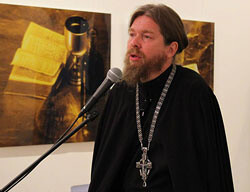

This is typical of conservatism. Form has priority over meaning. Structures are more important than the people who inhabit them. To put it in “creative” terms, format reigns over content, packaging over products, the magazine cover over what’s inside. The “image and likeness” of God is yet another format, an outer frame, a frame of conservatism. The “image and likeness” of God is packaging for yet another commodity. And vice versa: the cult of the commodity form reproduces the logic of conservatism. Every copywriter and every journalist like me aids and abetts Shevkunov through his or her activity. The culture industry is religion in its most conservative form. Capitalism is the religion of institutions.
I am a descendant of apes in the body of an ape. I came from apes, and I’m proud of it: let that be my content, if you want to give me a form. I was born and raised in this rotting, self-eating nature, endlessly caught up in constantly becoming something more, eternally and palpably setting out towards somewhere else (and not always upward). Whatever I produce is not just made for some ready-made package, it’s also the obscure fruit of obscure investigations. Emancipation is the return of form to content. That is, the return to humanity. Throw off your garment, young Sergei!
Of course, anarchist impulses of irritation in the spirit of Celine’s novels—destructive, sexualized, and subversive—are not enough to change the situation, as enlivening as they might be. But this impulse merely points toward the boiling up of the repressed and the discarded. What can we do so that to this boiling up isn’t just “bourgeois culture turned inside out”? How do we keep it from being reduced to the convulsion of delirium that falls upon the first victim at hand (“clammy palms,” “inner smile,” “voluptuous Russian Orthodoxy”)?
We need another system to give rise to meaning, one that does not delimit form from content, a delimitation that has the triumph of form as its consequence. Not the power of consensus, not the power of an ossified party or a church, not the power of capital or the image-makers. It’s time to grow flowers on garbage. That was the basis for hope once vested in the revolutionary role of the proletariat.
Mikhail Nesterov (1862–1942), major Symbolist painter.
Translated from the Russian by David Riff.
This text was first published in Russian at colta.ru.

